Bioprocess Containers Market Size and Trends
Global bioprocess containers market is estimated to be valued at USD 4.21 Bn in 2025 and is expected to reach USD 11.08 Bn by 2032, exhibiting a compound annual growth rate (CAGR) of 14.8% from 2025 to 2032.
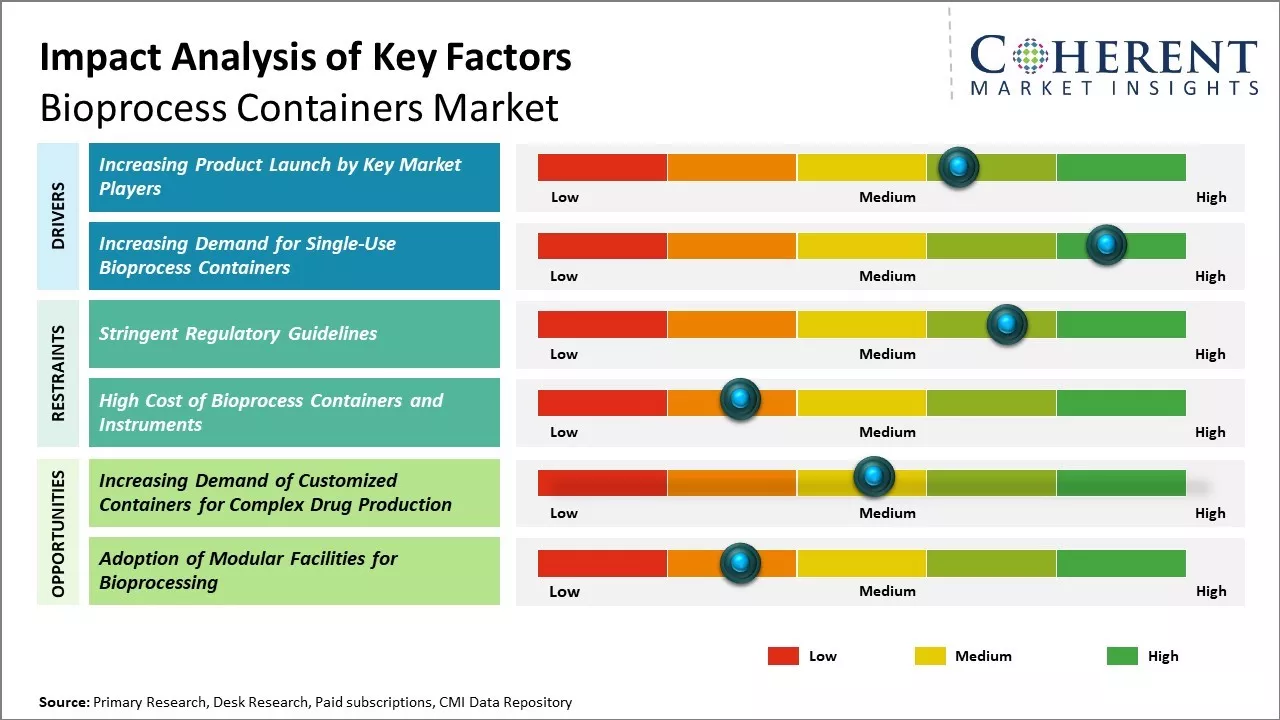
Discover market dynamics shaping the industry: Download Free Sample
Global bioprocess containers market is witnessing growth due to increasing monoclonal antibody production. Rising adoption of personalized medicine and growing demand for genetically engineered products boosts the need for increased bioprocessing capacity. However, the market faces challenges such as lack of standardized regulatory framework. But continued technological advancements in production processes is expected to drive the bioprocess containers market.
Market Driver – Increasing Product Launch by Key Market Players
Increasing adoption of organic growth strategies such as product launches by key market players is expected to drive the global bioprocess containers market growth over the forecast period. For instance, in February 2021, Thermo Fisher Scientific, Inc., a medical device company, announced the launch of single-use, sterilized, closed-system bioprocess container (BPC) that is designed to offer a highly efficient alternative. CentriPAK BPC enables optimal protection of critical sterile liquids from cross-contamination typically associated with reusable containers.
Market Concentration and Competitive Landscape
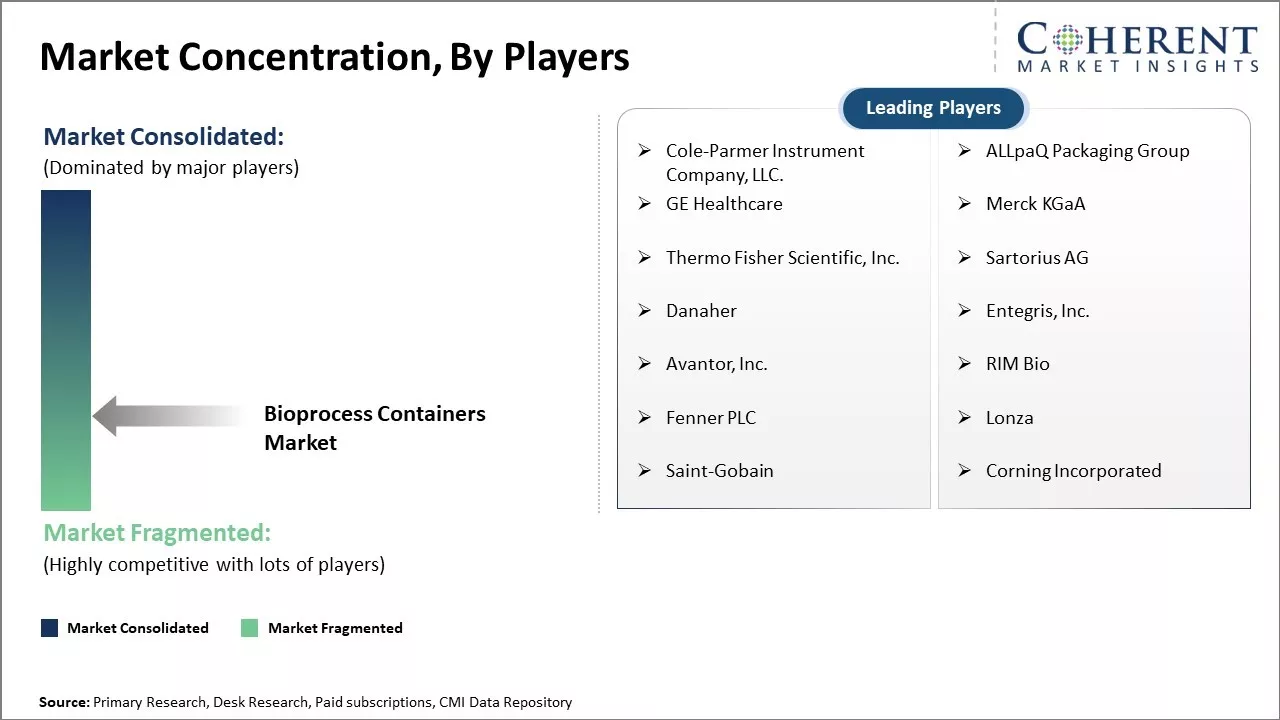
Get actionable strategies to beat competition: Download Free Sample
Market Driver – Increasing Demand for Single-Use Bioprocess ContainersThe biopharmaceutical industry has been witnessing a significant transition from traditional stainless-steel bioreactors to single-use bioprocess containers in the recent years. Many manufacturers are actively switching to single-use technologies for fermentation as well as downstream and upstream applications as it provides numerous advantages over traditional systems. Single-use bioprocess containers have substantially reduced the costs associated with cleaning and validation of stainless-steel equipment. These eliminate the need for complex and expensive cleaning procedures between production batches. This allows for faster production turnarounds and greater manufacturing flexibility. New therapies and drugs can be quickly developed and brought to clinical trials. This has become a critical necessity as the demand for personalized medicines and complex biologics increases. Many biopharma companies involved in gene and cell therapies heavily rely on single-use technologies due to their processing sensitivities. Any residual contaminants left behind during cleaning can potentially compromise the efficacy and safety of these advanced therapies. The sterility and consistency assured by single-use systems are particularly valuable for products requiring high purity levels.
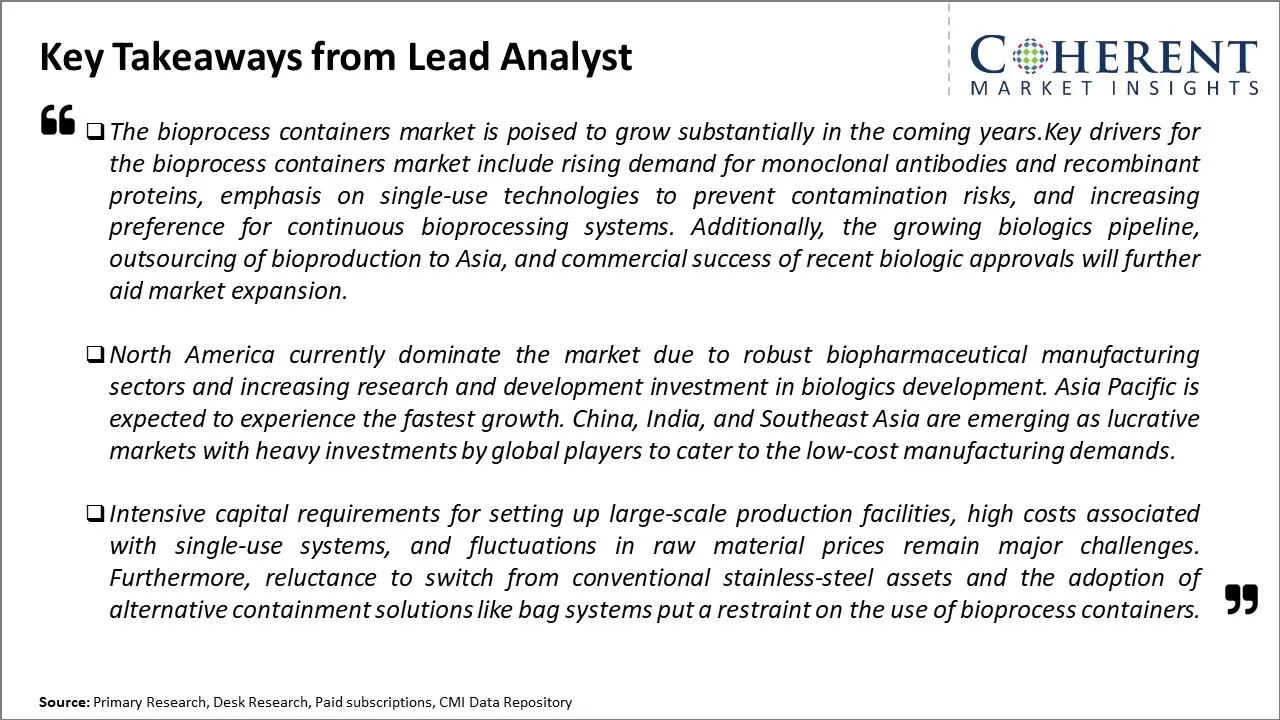
To learn more about this report, Download Free Sample
Market Challenges – Stringent Regulatory GuidelinesStringent regulatory guidelines from government agencies can hamper the growth of the global bioprocess containers market. Bioprocessing involves handling of sensitive biological material and there are high risks of contamination, so regulators have mandated strict compliance with good manufacturing practices. The regulatory processes have become very complex and time-consuming which increases compliance costs for manufacturers. The complexity of regulations also poses challenges for globalization of operations. Manufacturing facilities located across countries must satisfy diverse regulatory standards, which increases costs of coordination and record-keeping. Any non-compliance can lead to import rejections or shutdowns creating disruptions. For instance, in 2022, the U.S. Food and Drug Administration tightened its guidelines of bioprocessing equipment manufactured in Asia Pacific and several shipments from China faced delays due to failure to meet new contamination prevention norms. This discourages setting up of production units overseas.
Market Opportunities – Increasing Demand for Customized Containers for Complex Drug Production
As biologics replace traditional pharmaceuticals, demand for containers customized for complex drug production will increase. Emerging biologics like vaccines, recombinant proteins and advanced therapies can boost needs for single-use flexible bags as well as robust glass and stainless-steel containers.
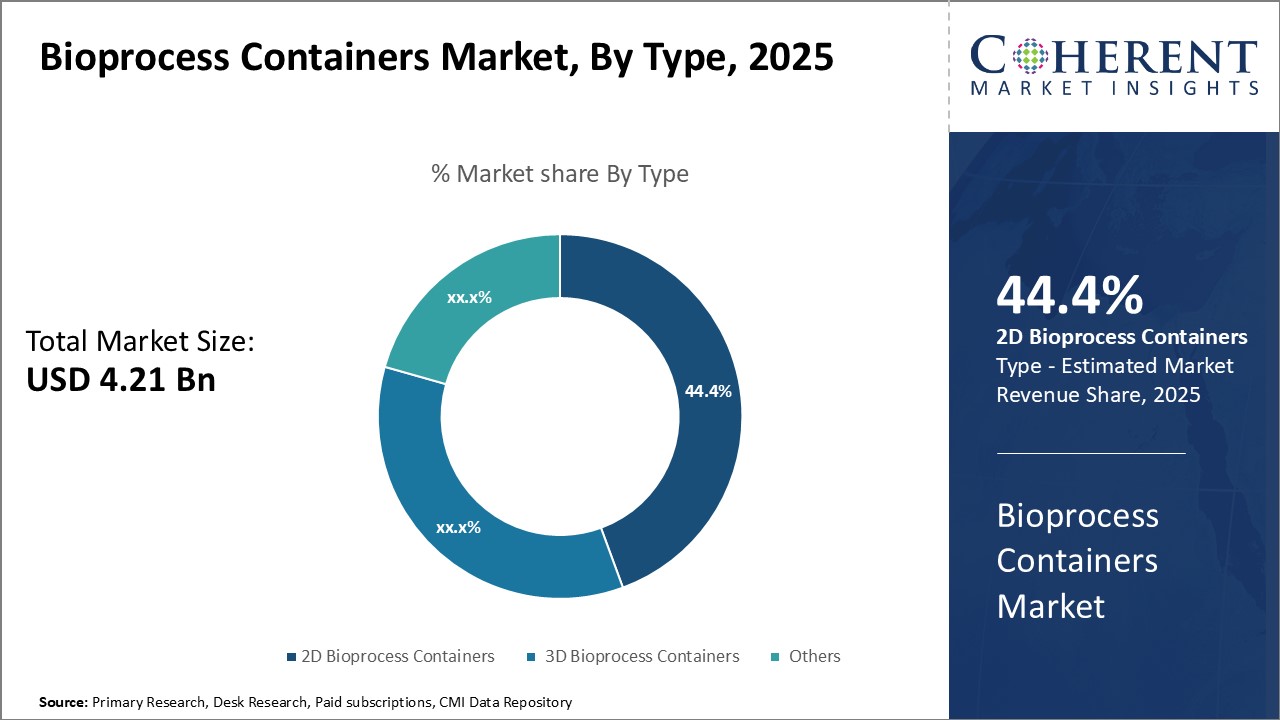
Discover high revenue pocket segments and roadmap to it: Download Free Sample
Insights, By Type: Widespread usage of 2D bioprocess containers in the production of monoclonal antibodies Can Drive the Segment GrowthType segment is sub-segmented into 2D bioprocess containers, 3D bioprocess containers, and others. 2D bioprocess containers segment is estimated to hold 44.4% share of the market in 2025, owing to its widespread usage in the production of monoclonal antibodies. Monoclonal antibodies have revolutionized therapeutic areas such as oncology and immunology in the recent years. Their ability to precisely target disease pathology with high specificity has resulted in improved treatment outcomes. Major pharmaceutical companies have witnessed blockbuster success with monoclonal antibody drugs and have extensive pipelines underway. 2D containers are well suited for large scale production of monoclonal antibodies due to their design advantages such as high surface to volume ratio and linear flow path optimal for cell growth. Their planar configuration also facilitates scale up while maintaining consistency in critical process parameters. Moreover, industry standards and regulatory guidelines are well established for 2D containers, simplifying validation requirements. With monoclonal antibody therapeutics expected to dominate the bioprocess containers market in the near future, demand for 2D containers optimized for their production will also increase.
Insights, By Application: Increasing focus on optimization of upstream processes
Application segment is sub-segmented into upstream processes, downstream processes, and process development. Upstream processes segment is expected to hold 39.9% of the market share in 2025, due to bioprocessing industry's intensifying focus on optimization of upstream operations in recent times. Continuous efforts are being made to improve cell line development, increase product titers and develop high yielding strains through advanced cell culture and fermentation techniques. However, optimization activities require processing on a smaller scale with flexibility to test multiple conditions efficiently. This favors single use bioprocess containers suitable for upstream applications. Their disposable nature further aids process development by removing cleaning and sterilization validation hurdles. As biomanufacturers seek advanced strategies like perfusion culture and fed batch processes to boost productivity and efficiency, demand for single use containers tailored for upstream optimization work increases. This durable trend can drive the growth of the upstream processes segment in the near future.
Insights, By End User: Importance of end-to-end Integration Driving Pharmaceutical and Biotechnology Companies Adoption
End User segment is sub-segmented into pharmaceutical and biotechnology companies, CROs & CDMOs, and others. Pharmaceutical and biotechnology companies segment is expected to hold 39.8% of the market share in 2025. Pharmaceutical and biotechnology companies recognize the importance of end-to-end integration of drug development and manufacturing. The outsource models were common but companies prefer in-house control over the entire value chain. However, achieving complete integration necessitates robust flexible infrastructure at all stages. Single use bioprocess containers have emerged as an ideal solution by providing scalability and adaptability. Their usage spans the entire product lifecycle from early cell line development to commercial production. It simplifies tech transfer between phases while maintaining integrity of the process.
Regional Insights
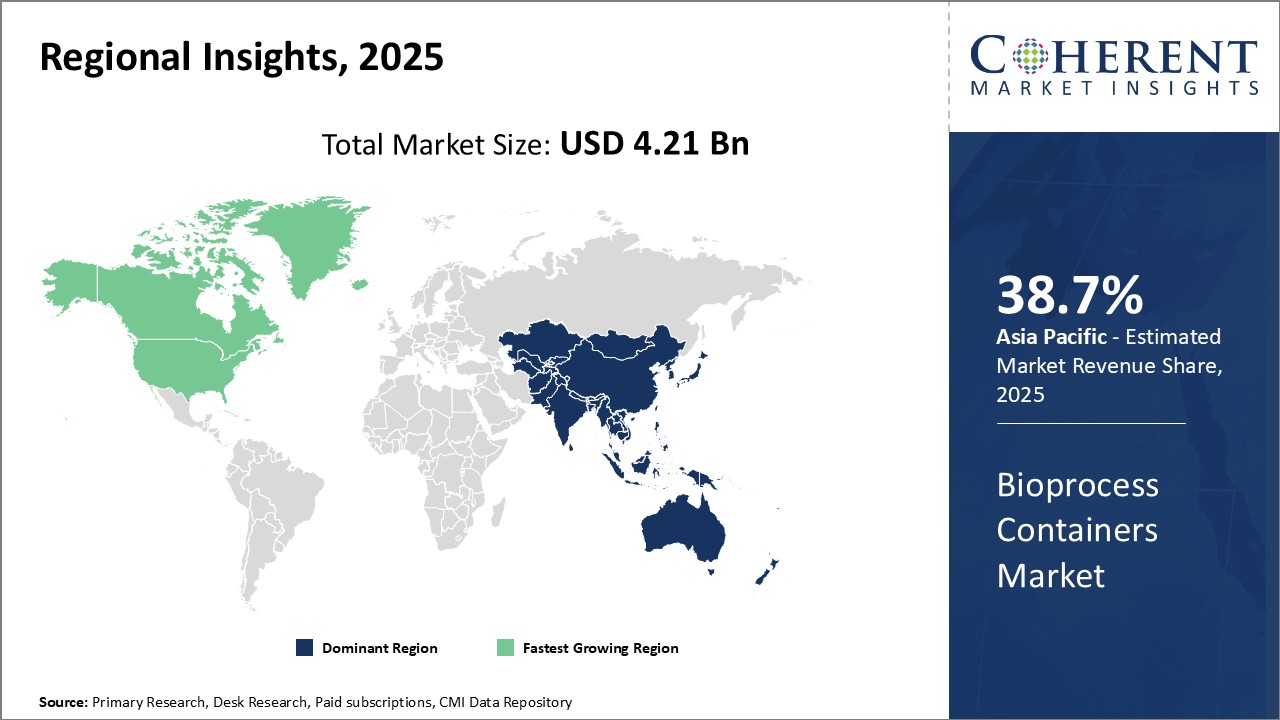
Need a Different Region or Segment? Download Free Sample
North America remained the dominant region in the global bioprocess containers market and is anticipated to hold 38.7% of the market share in 2025. With a strong presence of top biopharmaceutical companies and vibrant research environment, the demand for containers is consistently high. The market is dominated by U.S. due to concentration of many industry giants and presence of well-established supply chain network. Most of the major players have their regional headquarters located in U.S. which enables them to directly serve the growing needs. This has made U.S. as ideal manufacturing base not just to meet domestic needs but also demands from other markets like Europe and Asia Pacific. The trade volumes between Canada and U.S. also contribute towards regional growth.
Asia Pacific region has emerged as the fastest growing market for bioprocess containers globally. Countries like China and India serve as global manufacturing hubs, which drives significant investments in setting up production facilities. With improving healthcare infrastructure and rising income levels, the biopharmaceutical demands within regional countries are increasing rapidly. The market is growing at fastest pace in Asia Pacific due to increased outsourcing of production activities by major players to countries like China and India. This enables them to benefit from low-cost skilled workforce. Additionally, these countries have taken several initiatives to attract FDIs and investments in pharmaceutical sector. The export of containers from regional countries to other parts has been consistently rising over years. The trade agreements between various nations are also supporting market expansion.
Market Report Scope
Bioprocess Containers Market Report Coverage
| Report Coverage | Details | ||
|---|---|---|---|
| Base Year: | 2024 | Market Size in 2025: | USD 4.21 Bn |
| Historical Data for: | 2020 To 2024 | Forecast Period: | 2025 To 2032 |
| Forecast Period 2025 to 2032 CAGR: | 14.8% | 2032 Value Projection: | USD 11.08 Bn |
| Geographies covered: |
|
||
| Segments covered: |
|
||
| Companies covered: |
Cole-Parmer Instrument Company, LLC., ALLpaQ Packaging Group, GE Healthcare, Merck KGaA, Thermo Fisher Scientific, Inc., Sartorius AG, Danaher, Entegris, Inc., Avantor, Inc., RIM Bio, Fenner PLC, Lonza, Saint-Gobain, Corning Incorporated |
||
| Growth Drivers: |
|
||
| Restraints & Challenges: |
|
||
Uncover macros and micros vetted on 75+ parameters: Get instant access to report
Bioprocess Containers Industry News
- In April 2023, Merck KGaA, a global pharmaceutical company, launched Ultimus Single-Use Process Container Film that is designed to provide extreme durability and leak resistance for single use assemblies used for bioprocessing liquid applications
- In April 2022, Thermo Fisher Scientific, Inc., a medical device company, announced the opening of its new single-use technology manufacturing site in Utah, U.S. to increase the production of single-use bioprocess containers that are critical to the development of new vaccines and therapies
- In March 2022, ILC Dover LP, a company specializing in innovative single-use solutions for biotherapeutics and pharmaceutical processing, announced its launch of liquid single-use bioprocessing bags, specifically for or rapidly growing biotherapeutics and cell & gene therapy markets
*Definition: Bioprocess containers consists of stainless steel and single-use flexible containers used for storage, mixing, transporting, and culturing of cells and cell products in the bioprocessing and biopharmaceutical industries. These include fermenters, bioreactors, mixers, storage containers, filtration and purification systems, sampling systems and other process equipment that are utilized in the manufacturing of biopharmaceuticals and vaccines as well as research and clinical applications. Bioprocess containers provide sterile, optimized.
Market Segmentation
- Type Insights (Revenue, USD Bn, 2020 - 2032)
- 2D Bioprocess Containers
- 3D Bioprocess Containers
- Others
- Application Insights (Revenue, USD Bn, 2020 - 2032)
- Upstream Processes
- Downstream Processes
- Process Development
- End User Insights (Revenue, USD Bn, 2020 - 2032)
- Pharmaceutical and Biotechnology Companies
- CROs & CDMOs
- Others
- Regional Insights (Revenue, USD Bn, 2020 - 2032)
- North America
- U.S.
- Canada
- Latin America
- Brazil
- Argentina
- Mexico
- Rest of Latin America
- Europe
- Germany
- U.K.
- Spain
- France
- Italy
- Russia
- Rest of Europe
- Asia Pacific
- China
- India
- Japan
- Australia
- South Korea
- ASEAN
- Rest of Asia Pacific
- Middle East
- GCC
- Israel
- Rest of Middle East
- Africa
- South Africa
- North Africa
- Central Africa
- North America
- Key Players Insights
- Cole-Parmer Instrument Company, LLC.
- ALLpaQ Packaging Group
- GE Healthcare
- Merck KGaA
- Thermo Fisher Scientific, Inc.
- Sartorius AG
- Danaher
- Entegris, Inc.
- Avantor, Inc.
- RIM Bio
- Fenner PLC
- Lonza
- Saint-Gobain
- Corning Incorporated
Share
Share
About Author
Komal Dighe is a Management Consultant with over 8 years of experience in market research and consulting. She excels in managing and delivering high-quality insights and solutions in Health-tech Consulting reports. Her expertise encompasses conducting both primary and secondary research, effectively addressing client requirements, and excelling in market estimation and forecast. Her comprehensive approach ensures that clients receive thorough and accurate analyses, enabling them to make informed decisions and capitalize on market opportunities.
Missing comfort of reading report in your local language? Find your preferred language :
Transform your Strategy with Exclusive Trending Reports :
Frequently Asked Questions
EXISTING CLIENTELE
Joining thousands of companies around the world committed to making the Excellent Business Solutions.
View All Our Clients
